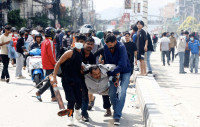Opinion
Rapid economic transformation
Nepal has set a long-term vision to graduate from the Least Developed Country (LDC) category by 2022 and attain a prosperous, middle-income country status by 2030.
Kenichi Yokoyama
Nepal has set a long-term vision to graduate from the Least Developed Country (LDC) category by 2022 and attain a prosperous, middle-income country status by 2030. The National Planning Commission is leading efforts to chart a bold and time-bound economic development roadmap to attain these goals.
In this regard, the remarkable economic transformation of several Asian economies in a matter of a few decades provides important lessons for Nepal in its quest to achieve rapid, sustainable and inclusive economic growth.
So far, Nepal’s economic transformation is not supported by growth-enhancing structural change. Economic structure and labour have shifted from low productivity agricultural to low productivity services, bypassing the industrial sector.
In 1984, agricultural, service-based and industrial sectors accounted for 61 percent, 26 percent and 13 percent of gross domestic product (GDP) respectively. Currently, while the agricultural sector accounts for 33 percent and the service sector a whopping 52 percent of GDP, industries account for just 15 percent of GDP. In effect, there is a gradual deindustrialisation since the industrial sector peaked at 23 percent of GDP in 1997.
Consequently, GDP growth has been low and volatile, depending mostly on the monsoon rains and remittance-fueled consumption demand in the service sector. Per capita GDP growth averaged just 2.6 percent in the last three decades, reaching $746 in 2016.
Similarly, real annual GDP growth averaged 4.2 percent in the last three decades. GDP growth was above 8 percent in two instances only: in 1981 and 1984. In 1994, it grew by 7.9 percent. The economy has to grow by an average 8 percent each year to achieve its goal of becoming a middle-income country.
Asian experience
The Asian experience—for instance the cases of Japan, Hong Kong, Singapore, Thailand, and Malaysia—provides valuable insight to initiate rapid structural transformation. These economies invested heavily in fundamentals and guided the economy with a clear vision, resulting in rapid and sustained economic growth. Initially, the structure of the economy was transformed by increasing the size and dynamism of the industrial sector.
Agriculture played an important role by increasing labour and land productivity, stimulating growth in backward and forward linkages such as agro-processing, and releasing a labour force to help industrialisation. These were supported by stable fiscal and monetary policies that were occasionally unorthodox, and an investment-friendly policy regime. These strategies led to a sustained high growth rate.
Furthermore, they invested heavily in infrastructure as a foundation for production and trading, prioritised human capital formation, fostered technology transfer, and strengthened institutions. This enhanced and sustained economic competitiveness and high per capita income levels.
These measures were crucial in boosting productivity and value addition in the industrial sector, and in diversification and sophistication of productive services such as financial and IT systems. Here, well-planned and developed urban infrastructure was a critical catalyst.
In essence, pragmatic industrial promotion strategies along with access to markets, capital and technologies of more advanced economies helped these economics to rapidly take-off and boost per capita income. A clear and pragmatic development vision, incremental reforms to boost critical physical and social infrastructure, and strong institutional fundamentals and ownership underpinned this transformative process.
Lessons for Nepal
The global investment, trade and financial regimes are different now compared to the times when these economies were taking-off and growing at high rates. As a latecomer, Nepal doesn’t have the same privileges, untapped potential and preferential market access opportunities.
However, it does have significant opportunities to spur high growth by catering to the needs of the growing internal and favourable external markets through hydroelectricity, light manufacturing goods, high value agriculture products, tourism, and information technology development. Overall, raising productivity across all sectors will be the key.
Note that enhancing per capita income to a middle-income level will be conditional on the correct positioning of micro and macro fundamentals. Faster catch-up is easier at this stage if productivity of agricultural and industrial sectors increases rapidly.
In particular, a competitive manufacturing sector, which produces tradable goods, absorbs more labour, provides sustained sources of income and boosts entrepreneurship, is essential to move up the ladder of industrialisation.
Nepal could point the macro fundamentals in the right direction by increasing the quantum and quality of investment in agriculture, transport, energy, urban development, education and skills, and healthcare. Nepal could also make progress by controlling inflation, improving governance and rolling out private sector friendly reforms.
Some of these measures are an integral part of the government’s “second generation reforms”. However, the lack of effective implementation of policies and timely budget execution are subduing growth potential. Similarly, the micro fundamentals that need to be addressed are labour relations, land reforms, and anti-competitive practices, which are fostering inefficiencies and stifling growth opportunities in all sectors.
As the backbone of the economy, agriculture supports growth and livelihoods and lowers price volatility. Thus, enhancing land and labour productivity is crucial for a meaningful transformation. Productivity could be increased by using new technology and shifting traditional cropping practices to more high value added activities such as livestock, fruits, vegetables and agro-processing. It should be supported by transport networks, development of value chains, credit flows, irrigation and marketing.
These call for well-structured programming and implementation of the Agriculture Development Strategy.
Following the enhancement of agriculture, strengthening the industrial sector is vital for generating meaningful jobs and accelerating growth. Provisioning of infrastructure and supportive policy and institutional reforms are critical. Also necessary are pragmatic industrial promotion strategies, which could range from import replacement and export promotion that hinge on increasing domestic value added and employment, to establishing functional industrial zones and economic corridors.
A range of industrial and trade policies/strategies are periodically updated and approved, but their effective implementation is not getting much attention.
Nepal has a latecomer advantage in the light manufacturing sector, which normally absorbs semi-skilled labour force—similar to the workers who migrate overseas. Hence, it could get spill over demands from countries where wages are rising fast, provided that factors that supress competitiveness such as inadequate power supply, high cost of transport, and labour relations are addressed.
Nepal could then gradually produce sophisticated goods that require higher knowledge, management skills and technology transfer. This would also complement high productivity services, ie moving from trading businesses to IT services, travel and tourism, and educational and healthcare services.
Government’s role
The government has an important role to play in providing critical infrastructure, addressing market failures, designing a growth-enhancing tax regime, and implementing business-friendly policies to usher in a meaningful structural transformation.
It also needs to enhance both the quantum and quality of public capital spending to over 8 percent of GDP annually. Given the sound fiscal space, though Nepal doesn’t have a shortage of funds until medium-term, a dearth of capacity to fully execute the budget and finish projects on time may prove problematic.
Implementing the vision of a rapid economic transformation would require consistent and committed political leadership, and a competent bureaucracy. This would form the institutional fabric that helps translate good economics into good politics with economic development as the core theme.
It ensures shared prosperity, makes reversibility of policies costly, enhances individual’s and firm’s confidence in the economy, and encourages the bureaucracy to provide faster and better service delivery.
With an appropriate mix of macroeconomic strategies, financial arrangements, smart project execution, and supportive institutions and policies, it is reasonable for Nepal to be upbeat about the possibility of a meaningful economic transformation and attainment of the long-term vision.
- Yokoyama is Country Director of Asian Development Bank, Nepal resident mission; Sapkota is an economist. Views expressed in this article are personal




 11.12°C Kathmandu
11.12°C Kathmandu










